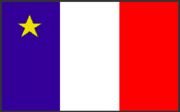Acadian
|
|
Acadians are the original French settlers of parts of the northeastern region of North America comprising what is now the Canadian provinces of Nova Scotia, New Brunswick and Prince Edward Island. Although Acadians and Quebeckers are two French-Canadian cultures, Acadia was founded 4 years before Quebec and in a geographically separate area. As such, both cultures are different.
| Contents |
History
During the 17th century about a hundred French families were established in Acadia. The Acadians avoided the disputes between the French and the British and developed friendly relations with the Aboriginal Mi'kmaq, learning their hunting and fishing techniques.
The Acadians became British subjects when France ceded Acadia by the Treaty of Utrecht (1713), and Acadia became known as Nova Scotia. When the French and Indian War began in 1754, the British government, doubting the neutrality of the Acadians, demanded that they take an oath of allegiance to the Crown. Most Acadians refused.
British Governor Charles Lawrence decided to deport the Acadians from Nova Scotia without giving his colleagues any notice. His army destroyed around 6000 Acadian houses and dispersed the Acadians to the 13 colonies from Massachusetts to Georgia. Several of these colonies refused to take in any refugees; such was the case with Virginia, which deported the Acadians to England and France.
This incident has been referred to as the Great Expulsion (Grand Dérangement) of 1755. In 2003, at the request of Acadian representatives, Elizabeth II, Queen of Canada, issued a proclamation officially acknowledging the deportation and establishing July 28 as a day of commemoration. [1] (http://www.globeandmail.com/servlet/story/RTGAM.20031203.wacad1203/BNStory/National/) The day of commemoration is observed by the Canadian government, as the successor to the British, but not by the British government which carried out the expulsion.
Families were separated and sent by ship into exile, where one third perished. Many, however, managed to hide in the woods or return to their homes over the following decades.
In 1764 the war was over, and the Acadians were granted permission to return to Nova Scotia; however, they were prohibited from settling in any one area in large numbers. Some Acadians therefore spread out along the Nova Scotia coast and remain scattered across Nova Scotia to this day.
Other Acadians were deported to France, especially in the slums of Nantes and on Belle-Isle off Brittany. The French islands of St. Pierre and Miquelon near Newfoundland became a safe harbour for many Acadian families until they were once again deported by the British in 1778 and 1793.
The Acadians virtually disappeared from history for a century after the Grand Dérangement, but they survived and experienced a minor cultural and political revolution in the 1880s.
Geography
The Acadians today inhabit the north and east shores of New Brunswick, the area around Moncton, the Magdalen Islands, and smaller pockets in Prince Edward Island and Nova Scotia such as Chéticamp, Clare, Annapolis Valley, Halifax-Dartmouth, Pomquet, Richmond and Sydney. There are also people of Acadian ancestry in Maine and Quebec. Some of the Acadians who were deported in 1755 were encouraged by the French king to settle in Louisiana, where their descendants, the Cajuns, have become a dominant cultural influence in many a Louisiana parish.
Culture
Today Acadians are a vibrant minority, particularly in New Brunswick and Maine.
Notable Acadians include singer Angele Arsenault, writer Antonine Maillet, boxer Yvon Durelle, former Governor General Roméo LeBlanc, and former New Brunswick premier Louis Robichaud, who was the first Acadian premier and who was responsible for modernizing education and the government of New Brunswick in the mid-20th century.
August 15, the feast of the Assumption, is the national feast day of the Acadians. The flag of the Acadians is the French tricolour with a golden star in the blue section, which symbolizes the Blessed Virgin Mary, the "Star of the Sea". The national anthem of the Acadians is "Ave, maris stella". On that day, the Acadians celebrate by having the tintamarre which consists mainly of a big parade where people can dress up with the colours of Acadia and make a lot of noise with basically anything.
In 2004 a "Congrès mondial acadien" was held in Nova Scotia to celebrate the 400th anniversary of the arrival of the first French speaking settlers in Canada. Musical festivals and theatrical productions displayed Acadian culture, and academics debated the meaning of Acadia in the 21st century. Debates included the best ways of preserving Acadian culture in an overwhelmingly English area, and what exactly an Acadian is in 2004. Some Acadians do not recognize more recent immigrants as true Acadians, although most people accept any French speaking maritimer as an Acadian.
Language
Acadians speak a dialect of French called Acadian French. Many of those in the Moncton area speak Chiac.
Legend
The American folklore hero, Paul Bunyan, is believed by some to have been influenced if not inspired by Acadian stories about lumberjacks.
The Expulsion in literature
In 1847 an epic poem by American writer Henry Wadsworth Longfellow, Evangeline, was loosely based on the events surrounding the 1755 deportation. The poem became an American classic.
Robbie Robertson wrote a popular song based on the Acadian Expulsion titled "Acadian Driftwood" that appeared on The Band's 1975 album, Northern Lights - Southern Cross.
See also
External links
- Lucie LeBlanc Consentino's Acadian Home (http://www.acadian-home.org) website is a respected and frequently cited source of information on Acadian history and genealogy.de:Akadier

